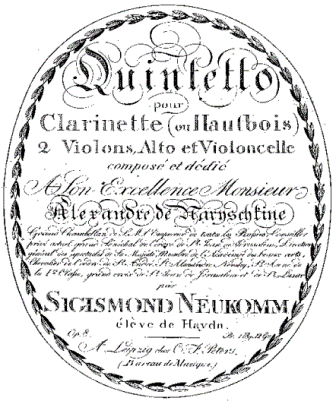Presents
Sigismund Neukomm
Quintet in B flat Major, Op.8 "Schöne Minka"
For Clarinet (or Oboe), 2 Violins, Viola and Cello
 Neukomm's Op.8 Quintet
dates from around 1815. It seems clear that he
intended it to be a Clarinet Quintet, however, as one can clearly see from the
cover to the original edition by C.F. Peters (reproduced on the left) that the
piece could also be used as a quintet for Oboe and Strings. No doubt, this was
the work of the publisher Peters who wished to maximize sales and insisted on an
oboe part, which one finds in their original edition.
Neukomm's Op.8 Quintet
dates from around 1815. It seems clear that he
intended it to be a Clarinet Quintet, however, as one can clearly see from the
cover to the original edition by C.F. Peters (reproduced on the left) that the
piece could also be used as a quintet for Oboe and Strings. No doubt, this was
the work of the publisher Peters who wished to maximize sales and insisted on an
oboe part, which one finds in their original edition.
The work is in four movements and opens with an introductory Adagio followed by a long and at times stormy Allegro. A charming Menuetto comes next. The most interesting movement is a Theme russe and set of variations. The Russian theme is taken from the Ukrainian folk song “Schöne Minka” (Pretty Minka) which was part of a collection of Russian folk melodies published in Vienna by Iwan Pratsch in 1800. Beethoven used several of these melodies as themes for his Rasumovsky String Quartets. “Schöne Minka” became quite popular in Vienna around 1814-15, so much so that a competition was sponsored by a Viennese music publisher for the best set of variations on the theme. While it is not known who won, it is known that several important composers entered. Among the works were Johann Nepomuk Hummel’s Op.78 Trio for Flute, Cello & Piano and Variations for Piano Solo by Beethoven and Carl Maria von Weber as well as Neukomm’s Clarinet Quintet. Schöne Minka is a sad song, the words were by the German poet Christoph August Tiedge and begin “Lovely Minka, I must part—” a Cossack saying good-bye to his girl. In Germany, the song was known by the French title, Les Adieux du Kosak. The Chamber Music Journal noted that Neukomm’s variations are better than both Beethoven’s and Hummel’s! The work concludes with a lively Rondo.
Sigismund Neukomm (1778-1858) was born in Salzburg. He studied composition with Michael Haydn. There were further studies in Vienna with Joseph Haydn (which is noted on the Peters' cover above). He held a number of positions including music director at St. Petersburg's German theatre. He traveled widely throughout Europe and even visited Brazil, where he popularized the works of Joseph Haydn and Wolfgang Mozart. Neukomm's compositional output is large. He wrote several operas, masses, oratorios, songs, works for piano solo as well as chamber music works. During his lifetime, he and his music were widely respected and he was regarded as being in the front rank of those composers from the Classical era after Haydn and Mozart. Despite the fame he achieved during the first half of the 19th century, his name and works fell into obscurity because he outlived the classical era by 50 years. This is a fate which might well have happened to Mozart had he lived so long. Certainly had Neukomm died before 1815, his reputation would have remained intact.
Our newly notated edition is based on the C.F. Peters edition. We have, of course, added rehearsal numbers. We have also included the original (i.e. not newly notated) oboe part but have added rehearsal numbers. It is perfectly readable though. Here is a work from the late Classical and early Romantic era which should be of interest to every Clarinet Quintet party, not to mention oboe players who are not exactly overly served.